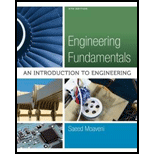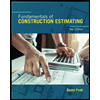
Engineering Fundamentals: An Introduction to Engineering (MindTap Course List)
5th Edition
ISBN: 9781305084766
Author: Saeed Moaveni
Publisher: Cengage Learning
expand_more
expand_more
format_list_bulleted
Concept explainers
Question
Chapter 6, Problem 10P
To determine
Investigate the operation of various turbines and explain the operation of steam turbines, hydraulic turbines, gas turbines, and wind turbines.
Expert Solution & Answer
Want to see the full answer?
Check out a sample textbook solution
Students have asked these similar questions
Q1/ The specific gravity of the soil is 1.41 percentage of water content by weight at
field capacity and wilting point are 15% and 7% respectively calculate the
equivalent moisture content as equivalent depth for 1.2m root zone :
1. at permanent wilting point
2. at field capacity
3. for ready available water
Kindy explain the pie chart percentage and give some related study and references about Value of travel time connected to the pie chart
Consider the specifications for an asphaltic concrete mixture and the results of a sieve analysis below.
Coarse aggregates:
Fine aggregates:
Filler:
60%
35%
5%
Percent of Weight of Aggregate or Filler
Passing
Sieve
Designation
Retained on
Sieve
Designation
Coarse
Aggregate
Fine
Aggregate
Mineral
Filler
3/4 in. (19 mm)
1/2 in.
6
1/2 in. (12.5 mm)
3/8 in.
15
3/8 in. (9.5 mm)
No. 4
50
-
No. 4 (4.75 mm)
No. 10
20
1
No. 10 (2 mm)
No. 40 (0.425 mm)
No. 40
9
35
-
No. 80
31
40
No. 80 (0.180 mm)
No. 200 (0.075 mm)
Total
No. 200
-
33
-
-
25
35
100
100
100
Determine the proportion of different aggregates to obtain the required gradation.
Percent of Total Weight of Mixture
Passing
Sieve
Designation
Retained on
Sieve
Designation
Coarse
Aggregate
Fine
Aggregate
3/4 in. (19 mm)
1/2 in. (12.5 mm)
3/8 in. (9.5 mm)
1/2 in.
3/8 in.
No. 4
No. 4 (4.75 mm)
No. 10
No. 10 (2 mm)
No. 40
No. 40 (0.425 mm)
No. 80
No. 80 (0.180 mm)
No. 200
No. 200 (0.075 mm)
Total
Need Help?
Read It
Mineral
Filler
Total
100
Chapter 6 Solutions
Engineering Fundamentals: An Introduction to Engineering (MindTap Course List)
Ch. 6.1 - Prob. 1BYGCh. 6.1 - Prob. 2BYGCh. 6.1 - Prob. 3BYGCh. 6.1 - Prob. 4BYGCh. 6.1 - Prob. BYGVCh. 6.2 - Prob. 1BYGCh. 6.2 - Prob. 2BYGCh. 6.2 - Prob. 3BYGCh. 6.2 - Prob. 4BYGCh. 6.2 - Prob. 5BYG
Ch. 6.2 - Prob. 6BYGCh. 6.2 - Prob. BYGVCh. 6.3 - Prob. 1BYGCh. 6.3 - Prob. 2BYGCh. 6.3 - Prob. 3BYGCh. 6.3 - Prob. 4BYGCh. 6.3 - Prob. BYGVCh. 6.5 - Prob. 1BYGCh. 6.5 - Prob. 2BYGCh. 6.5 - Prob. 3BYGCh. 6.5 - Prob. 4BYGCh. 6.5 - Prob. BYGVCh. 6.6 - Prob. 1BYGCh. 6.6 - Prob. 2BYGCh. 6.6 - Prob. 3BYGCh. 6.6 - Prob. BYGVCh. 6 - Prob. 1PCh. 6 - Prob. 2PCh. 6 - Prob. 3PCh. 6 - Prob. 4PCh. 6 - Prob. 5PCh. 6 - Prob. 6PCh. 6 - Prob. 7PCh. 6 - Prob. 8PCh. 6 - Prob. 9PCh. 6 - Prob. 10PCh. 6 - Prob. 11PCh. 6 - Prob. 12PCh. 6 - Prob. 13PCh. 6 - Prob. 14PCh. 6 - Prob. 15PCh. 6 - Prob. 16PCh. 6 - Prob. 17PCh. 6 - Prob. 18PCh. 6 - Prob. 19PCh. 6 - Prob. 20PCh. 6 - Prob. 21PCh. 6 - Prob. 22PCh. 6 - Prob. 23PCh. 6 - The air resistance to the motion of a vehicle is...Ch. 6 - Prob. 25PCh. 6 - Prob. 26PCh. 6 - Prob. 27PCh. 6 - Prob. 28PCh. 6 - Prob. 29PCh. 6 - Prob. 30PCh. 6 - Prob. 31PCh. 6 - Prob. 32PCh. 6 - Prob. 33PCh. 6 - The calorie is defined as the amount of heat...Ch. 6 - Prob. 35PCh. 6 - Prob. 36PCh. 6 - Prob. 37PCh. 6 - Prob. 38PCh. 6 - Prob. 39PCh. 6 - Prob. 40PCh. 6 - For the fin equation described in Problem 6.25, if...Ch. 6 - Prob. 42PCh. 6 - Prob. 43PCh. 6 - Prob. 44PCh. 6 - Prob. 45PCh. 6 - Prob. 46PCh. 6 - Prob. 47PCh. 6 - Prob. 48PCh. 6 - Prob. 49PCh. 6 - Prob. 50PCh. 6 - Prob. 51P
Knowledge Booster
Learn more about
Need a deep-dive on the concept behind this application? Look no further. Learn more about this topic, civil-engineering and related others by exploring similar questions and additional content below.Similar questions
- Results obtained from laboratory tests on a sample of RC-250 asphalt cement are given. Determine whether the properties of this material meet the Asphalt Institute specifications for this type of material; if not, note the differences. (For each specification, enter the minimum acceptab value in the same units as used in the test results.) • Kinematic viscosity at 140°F (60°C) = 230 centistokes • Flash point (Tagliabue open cup) = 89°F • Distillation test where distillate percent by volume of total distillate to 680°F (360ºC) • To 437°F (225°C) = 27% • To 500°F (260°C) = 69% • To 600°F (316°C) = 72% • Residue from distillation to 680°F (360°C) by volume percentage of sample by difference • Tests on Residue from Distillation: • Ductility at 77°F (25°C) = 92 cm • Absolute viscosity at 140°F (60°C) = 620 poises ⚫ Solubility = 90% Property Kinematic Viscosity = 74% Specification Test Results Were Specifications Met? centistokes 230 centistokes ---Select--- ✓ Flash Point °F 89°F…arrow_forwardProblem 2 Two machines produce rivets for a factory job. The number of sub-standard rivets per hour by the two machines are random variables, denoted by X1 and X2. The bivariate PMF of X1 and X2, Px,x,(x1,x2), is given in the table below. X2=0 X2=1 X2=2 X2=3 X₁-0 0.07 0.05 0.02 0.01 X₁ =1 0.05 0.16 0.12 0.02 X₁ =2 0.02 0.12 0.17 0.05 X₁ =3 0.01 0.01 0.05 0.07arrow_forwardPlease provide a handwritten solution to the questionarrow_forward
- AS Q1/ The specific gravity of the soil is 1.41 percentage of water content by weight at field capacity and wilting point are 15% and 7% respectively calculate the equivalent moisture content as equivalent depth for 1.2m root zone : 1. at permanent wilting point 2. at field capacity 3. for ready available waterarrow_forwardQuestion 6 The following figure shows peak-hour volumes for an intersection. Using Webster's method, determine a suitable signal timing for the intersection using the four-phase system shown below. Use an amber interval of 3 seconds and the saturation flow given in the table. O 100 O Phase Lime Group Saturation Flow A e 1615-> 370 3700 B 1615 1615 3700 1615 3700arrow_forwardPHF-0.91 Pedestrian volume is negligible. Question 7 A parking area with 60 bays has an initial count of 35 vehicles. The in-out survey data for 10-minute intervals is as per the table below. Complete the table, calculate the accumulation, occupancy (%), and parking load (veh.hrs) for each interval. Time (min) In Out Accumulation Occupancy Parking load (%) 0 3 10 2 4 20 1 1 30 1 3 40 1 6 50 1 4 60arrow_forward
- Q3/ The following data represent the water depth in the soil of equal areas for specified field. Calculate the uniformity coefficient, efficiency and adequacy of irrigation. Net needed irrigation depth =75 mm (78-04, 79, 88, 85.21, 76,82)arrow_forwardA (A) Q1/ It is required to apply a net depth of 120mm to a total area of 60 ha. The applied discharge is continuously 180 L/s. What must be the time of irrigation? Assume the application efficiency 85%. а Eas 85 0% tarrow_forwardThe following figure is a flexible pavement system with the resilient moduli layer coefficients and drainage coefficients as shown. If the predicted ESAL = 6x106, Reliability, R = 99%, Standard Deviation (So) = 0.45, and APSI = 2.5, select thicknesses D1, D2, and D3 in accordance with the AASHTO Guide for Design of Pavement Structures. E₁ = 400, 000 psi; a₁ = 0.42, Thickness = D₁ E₂=30,000 psi; a₂= 0.14, m₂ = 1.2; Thickness = Dz E=11,000 psi; a=0.08, m3 = 1.2; Thickness = D3 MR= 5,700 psiarrow_forward
arrow_back_ios
SEE MORE QUESTIONS
arrow_forward_ios
Recommended textbooks for you
 Engineering Fundamentals: An Introduction to Engi...Civil EngineeringISBN:9781305084766Author:Saeed MoaveniPublisher:Cengage Learning
Engineering Fundamentals: An Introduction to Engi...Civil EngineeringISBN:9781305084766Author:Saeed MoaveniPublisher:Cengage Learning
 Fundamentals Of Construction EstimatingCivil EngineeringISBN:9781337399395Author:Pratt, David J.Publisher:Cengage,
Fundamentals Of Construction EstimatingCivil EngineeringISBN:9781337399395Author:Pratt, David J.Publisher:Cengage, Sustainable EnergyCivil EngineeringISBN:9781133108689Author:Richard A. DunlapPublisher:Cengage Learning
Sustainable EnergyCivil EngineeringISBN:9781133108689Author:Richard A. DunlapPublisher:Cengage Learning

Engineering Fundamentals: An Introduction to Engi...
Civil Engineering
ISBN:9781305084766
Author:Saeed Moaveni
Publisher:Cengage Learning


Fundamentals Of Construction Estimating
Civil Engineering
ISBN:9781337399395
Author:Pratt, David J.
Publisher:Cengage,

Sustainable Energy
Civil Engineering
ISBN:9781133108689
Author:Richard A. Dunlap
Publisher:Cengage Learning